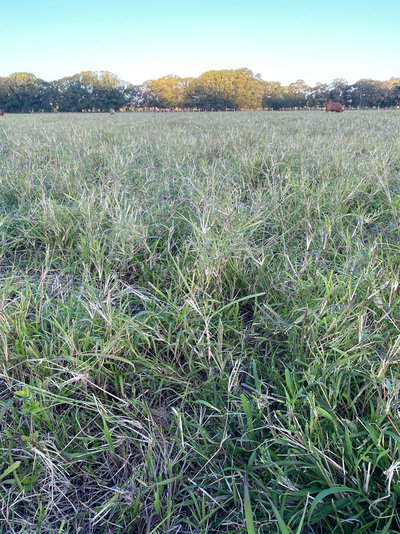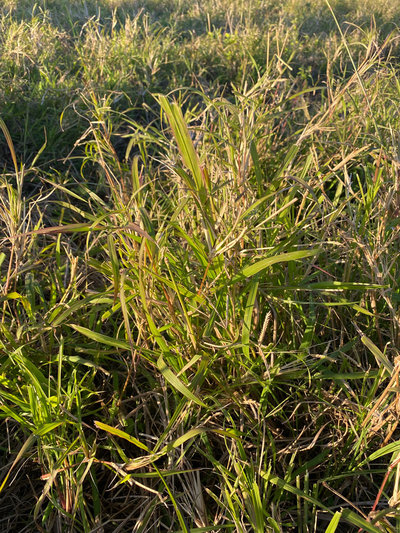Australia
October 6, 2022

Figure 1 Hereford Droughtmaster cross herd in Northern Rivers NSW thriving on Panic grass and Endura Rhodes grass pasture
Rain has been a common theme for eastern Australia during 2022. And not tropical wet season rain, but one in a hundred-year events that completely swamp the district.
The flood events in the Northern Rivers region of New South Wales, was devastating for many. The first rain event in late February saw 670mm fall across two days in the Lismore district with floodwaters reaching 10m in the town. Across March, intermittent rain was not a major concern, but the three day rain event in late March broke more than many river banks, with more than 300mm adding to the already waterlogged environment.
Under these circumstances, many farmers not only moved livestock to higher ground or agisted elsewhere wherever possible, but the aftermath for farm structures and pasture continued to create longer term problems for feed in the coming seasons.
Steve Herne’s family farm is situated near Marom Creek. It is comprised of undulating hills, the creek, prime pasture and a swamp area. A typical flood event for him, represents the creek breaking its banks but rarely does floodwater reach the pasture paddocks.
This year not only did the creek break its banks, but it also reached the higher points of the farm, with floodwaters reaching the top of the fence. It did not bode well for the pasture underneath.

Figure 2 The mix of MegaMax 059 Panic grass and Endura Phodes grass has recovered from the flooding and cattle are back grazing
Steve returned to the family farm seven years ago to manage the property, discovering that it had not been managed well and the pasture paddocks failed to flourish. With a mindset to renovate the paddocks, Steve set about eradicating weeds predominately fireweed and tobacco trees during 2021, planting an annual ryegrass to help compete against any weed regrowth.
In December 2020 at a field day in Grafton, Steve learned about a coastal mix of Endura Rhodes grass and MegaMax 059 Panic grass that had performed well in trials in the district. Planting ideally should be the following January.
12 months after the field day, the preparation work was completed in November 2021, and he was ready to plant the coastal mix. Taking advantage of a local fertiliser contractor, Steve combined the fertiliser with the seed mix to sow and fertilize in the one pass. By early February the grasses had established well and would tolerate a first graze by his Hereford Droughtmaster cross herd. Three weeks later the rain came.
“That initial growth was picture perfect,” says Steve. “After years of not having any growth that was worth mowing, it was satisfying to see the Rhodes and panic grass come up so well, and the cattle were fat, and we were getting good prices for the weaner steers.
“It was easy to grow, the cattle loved it and my plan was to mulch it back into the ground.
“The first flood event was definitely bad, but in our area, it always drains off and dries within a few days. The few showers in the following weeks kept the water levels topped up, so that when the second event hit a month later, we actually had a tsunami effect – with water receding one way, and incoming flood water coming the other. There was nothing you could do but wait.”
Inspecting the damage, Steve had lost about 300m of fencing, he was reasonably lucky. The cattle were safely agisted on other properties while the ground was flooded. The pasture paddocks, however were a mat of dead and rotting grass. He couldn’t imagine how he would restore it.

Figure 3 After significant flooding, the MegaMax 059 Panic grass has bounced back well to provide pasture.
Once it had dried enough to get vehicles on, another 40 bags of ryegrass were sown, as much to compete with the inevitable fireweed. As Steve says, there was no possible way of cultivating the matted rotting grass.
Surprisingly, the coastal mix has weathered the storm. Both the Endura Rhodes grass and more so, the MegaMax 059 Panic grass have survived many days of being completely under water. By mid August, the pasture has set seed, and half of Steve’s herd are back grazing now that the ground is firm enough not to be chopped up. Steve’s plan now, is to fertilise in the lead up to spring, to bring on further growth, promote recruitment of new seedlings and bring the remaining cattle back to the farm.
“It is reassuring for Steve that he will have quality pasture for his cattle post the floods, without needing to replant” says Territory Manager, Sam Adams.
“We were surprised as anyone that the coastal mix has bounced back as well as it has given the difficulties the young pasture has faced. It is a testament to Steve’s management and the quality of the varieties, I believe, that Steve will have many seasons ahead grazing this mix of Endura Rhodes and Megamax 059 Panic grasses.”